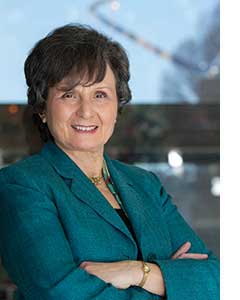
“For as long as I can remember, I had an interest in the natural world around me—how it worked, how things were put together,” recalls Frederica Darema (M.S. PHYS ’72) in a recent telephone conversation. “Before I went to kindergarten,” she says, pausing briefly before continuing with a tone of seeming wonder in her voice, “I was thinking about how the clouds stayed up in the sky and how is it that we see the moon everywhere we go, that it seems to follow us.”
Darema’s inquisitive nature—encouraged by her father, a pharmaceutical chemist—and her love of performing experiments in both elementary school and high school led to her focus on physics. A pamphlet about her native Greece’s then new Nuclear Research Center “Demokritos,” now the National Centre of Scientific Research, became the catalyst for her scientific aspirations. She graduated from the School of Physics and Mathematics at the University of Athens and was awarded a six-year Fulbright Scholarship to attend Illinois Institute of Technology and then the University of California, Davis, where she obtained a Ph.D. in physics with an emphasis on theoretical nuclear physics.
Her passion and aptitude for physics along with unswerving dedication to her work were fertile ground for Darema, who acknowledges plentiful opportunities to work with and be mentored by influential nuclear theorists beginning with her IIT years. Her research career path led her to develop the SPMD computational model for parallel and distributed computing, which continues to be the predominant model for supercomputing for more than 30 years now.
“My model allowed efficient ways of writing programs to exploit multiple computers, all working synergistically, to execute different parts of a computer program,” explains Darema, who proposed the idea in 1983, while working as a research staff member at the IBM T. J. Watson Research Center.
“As a physicist with a background in computational modeling, I thought of a completely different programming model for parallel computing than the fork/join (or master/slave) model that computer scientists were considering. Based on my understanding of physics models of nuclear phenomena, I was inspired and proposed the single program-multiple data model. The model was both democratic and capitalistic!” she adds, in characteristic good humor.
A few years earlier, when she was on the technical staff of Schlumberger-Doll Research Center, Darema had the idea for a new modeling paradigm that was well ahead of its time; the then-existing science and technologies were not advanced enough to support and implement the full capabilities of this new modeling method. After she developed her parallel-computing model and distributed computing was more commonly utilized, Darema pushed for her new concept through the InfoSymbiotics/Dynamic Data-Driven Applications Systems (DDDAS) Program, which she began to set in motion in the late 1990s as senior science and technology advisor for the National Science Foundation.
Recruited in 2010 by the United States Air Force Office of Scientific Research (AFOSR) to be director of the Mathematics, Information and Life Sciences Directorate, Darema was given the opportunity one year later to build and manage her visionary computer science program exclusively. While the DDDAS concept—which dynamically integrates modeling and instrumentation methods to analyze, understand, and manage the behavior of natural or engineered systems—will largely contribute to Air Force and national security projects, it also creates new capabilities in a broad set of areas in the civilian and commercial sectors. With the DDDAS program, the onset and path of tornadoes, hurricanes, and the spread of volcanic ash can be more accurately predicted; the compositional integrity of engineered structures such as airplanes, bridges, and tall buildings can be more accurately assessed; and critical infrastructures such as electrical power grids and transportation can be more intelligently and effectively managed.
Darema was elected an IEEE Fellow and received the Distinguished Professional and Technical Contributions Award and the Computer Society Award for Technical Achievements. Last spring, she was also honored with a 2013 IIT Professional Achievement Award. Sangtae Kim, Distinguished Professor at the Purdue University School of Chemical Engineering, notes that her IIT award is well deserved.
“Frederica Darema has made enormous contributions to the modern landscape of computational science,” says Kim, a member of the National Academy of Engineering. “In particular, the concept that she created and established—DDDAS—has proven to be a visionary paradigm for thinking about how big/dynamic data can be best incorporated into advanced mathematical/computational models; furthermore, DDDAS provides a powerful framework for implementing that vision into practice across some of the most important endeavors in applied science today. Fields as diverse as systems biology, advanced materials design, and energy production have all benefited from these computational advances.”
Thinking back to her IIT years, Darema remembers fondly her time as a student in the Department of Physics. She also enjoyed living on Main Campus, and visiting Chinatown and The Field Museum with her classmates. She admits, though, that she spent much of her time learning as well as on her research, especially at Argonne National Laboratory.
“Through the millennia, science and technology have played a major role in advancing civilization. Contributing my part in this has been very fulfilling,” says Darema. “Whatever I do in the future, I hope it will continue to capitalize on my experience and my track record, and provide me with challenges and opportunities to create new directions that will expand the horizons of science and technology.”
Editor’s Note: IIT Magazine thanks the IIT Office of Alumni Relations for providing interview notes for this article.
More Online
AFOSR: www.wpafb.af.mil/afrl/afosr/
“New Frontiers Through Information Technologies”: ieeexplore.ieee.org/document/6126643/?arnumber=6126643